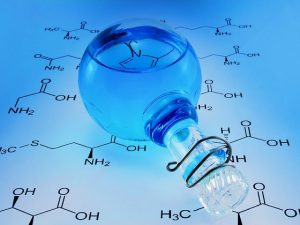 See our list of organic chemistry research paper topics. Organic chemistry is the science of compounds of carbon. The name organic goes back to a much earlier time in history when chemists thought that chemical compounds in living organisms were fundamentally different from those that occur in nonliving things. The belief was that the chemicals that could be extracted from or that were produced by living organisms had a special “vitalism” or “breath of life” given to them by some supernatural being. As such, they presented fundamentally different kinds of problems than did the chemicals found in rocks, minerals, water, air, and other nonliving entities. The chemical compounds associated with living organisms were given the name organic to emphasize their connection with life.
See our list of organic chemistry research paper topics. Organic chemistry is the science of compounds of carbon. The name organic goes back to a much earlier time in history when chemists thought that chemical compounds in living organisms were fundamentally different from those that occur in nonliving things. The belief was that the chemicals that could be extracted from or that were produced by living organisms had a special “vitalism” or “breath of life” given to them by some supernatural being. As such, they presented fundamentally different kinds of problems than did the chemicals found in rocks, minerals, water, air, and other nonliving entities. The chemical compounds associated with living organisms were given the name organic to emphasize their connection with life.
Organic Chemistry Research Paper Topics
- Carbon family
- Coal
- Cyclamate
- Dioxin
- Fermentation
- Hydrogen
- Hydrologic cycle
- Lipids
- Natural gas
- Nitrogen cycle
- Nitrogen family
- Oil spills
- Oxygen family
- Ozone
- Petroleum
- Vitamin
In 1828, German chemist Friedrich Wöhler (1800–1882) proved that this theory of vitalism was untrue. He found a very simple way to convert chemical compounds from living organisms into comparable compounds from nonliving entities.
Academic Writing, Editing, Proofreading, And Problem Solving Services
Get 10% OFF with 24START discount code
As a result of Wöhler’s research, the definition of organic chemistry changed. The new definition was based on the observation that every compound discovered in living organisms had one property in common: they all contained the element carbon. As a result, the modern definition of organic chemistry—as the study of carbon compounds—was adopted.
Organic and Inorganic Chemistry
One important point that Wöhler’s research showed was that the principles and techniques of chemistry apply equally well to compounds found in living organisms and in nonliving things. Nonetheless, some important differences between organic and inorganic (not organic) compounds exist. These include the following:
- The number of organic compounds vastly exceeds the number of inorganic compounds. The ratio of carbon-based compounds to noncarbon- based compounds is at least ten to one, with close to 10 million organic compounds known today. The reason for this dramatic difference is a special property of the carbon atom: its ability to join with other carbon atoms in very long chains, in rings, and in other kinds of geometric arrangements. It is not at all unusual for dozens, hundreds, or thousands of carbon atoms to bond to each other within a single compound—a property that no other element exhibits.
- In general, organic compounds tend to have much lower melting and boiling points than do inorganic compounds.
- In general, organic compounds are less likely to dissolve in water than are inorganic compounds.
- Organic compounds are likely to be more flammable but poorer conductors of heat and electricity than are inorganic compounds.
- Organic reactions tend to take place more slowly and to produce a much more complex set of products than do inorganic reactions.
Functional Groups and Organic Families
The huge number of organic compounds requires that some system be developed for organizing them. The criterion on which those compounds are organized is the presence of various functional groups. A functional group is an arrangement of atoms that is responsible for certain characteristic physical and chemical properties in a compound. For example, one such functional group is the hydroxyl group, consisting of an oxygen atom and hydrogen atom joined to each other. It is represented by the formula -OH.
All organic compounds with the same functional group are said to belong to the same organic family. Any organic compound that contains a hydroxyl group, for instance, is called an alcohol. All alcohols are similar to each other in that: (1) they contain one or more hydroxyl groups, and (2) because of those groups, they have similar physical and chemical properties. For example, alcohols tend to be more soluble in water than other organic compounds because the hydroxyl groups in the alcohol form bonds with water molecules.
The simplest organic compounds are the hydrocarbons, compounds that contain only two elements: carbon and hydrogen. The class of hydrocarbons can be divided into subgroups depending on the way in which carbon and hydrogen atoms are joined to each other. In some hydrocarbons, for example, carbon and hydrogen atoms are joined to each other only by single bonds. A single bond is a chemical bond that consists of a pair of electrons. Such hydrocarbons are known as saturated hydrocarbons.
In other hydrocarbons, carbon and hydrogen atoms are joined to each other by double or triple bonds. A double bond consists of two pairs of electrons, and a triple bond consists of three pairs of electrons. Hydrocarbons containing double and triple bonds are said to be unsaturated.
Hydrocarbons can also be open-chain or ring compounds. In an open-chain hydrocarbon, the carbon atoms are all arranged in a straight line, like a strand of spaghetti. In a ring hydrocarbon, the carbons are arranged in a continuous loop, such as a square, a pentagon, or a triangle.
Back to Science Research Paper Topics.




